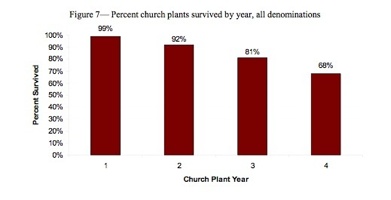Which new churches survive?
 I've just received a copy of Stetzer and Connor's Church Plant Survivability and Health Study 2007.
I've just received a copy of Stetzer and Connor's Church Plant Survivability and Health Study 2007.
The good news is around 68 percent of US church plants still exist four years after having been started. The claim that 80% of church plants 'fail' can be laid to rest. I never did believe it.
Even better, the research identifies these significant factors associated with church plant health and survivability.
1. Church plant expectations If, for the church planter, the expectations of the church plant meet the reality of the church planting experience, the chance of survivability increases by over 400 percent. Of those who said their expectations were realized, 87 percent of their churches survived compared to only 61 percent of church plants survived among those who did not have their expectations met.
2. Church member leadership development If the church planter provides leadership development training for new church members, the odds of survivability increase by over 250 percent. Of those church planters who provided leadership training to church members, 79 percent of their churches survived compared to only 59 percent of church plants survived among those who did not provide leadership training.
3. Church planter peer group The church planter meeting with a group of church planting peers at least monthly increases the odds of survivability by 135 percent. We found that out of those church planters who were part of a peer group, 83 percent of their churches survived whereas only 67 percent of church plants among those who did not have a peer group survived.
4. Stewardship plan The church plant having a proactive stewardship development plan enabling the church to be financially self-sufficient increases the odds of survivability by over 178 percent. Of those church plants who had a stewardship development plan, 81 percent of churches survived whereas only 68 percent of church plants survived among those who did not have a stewardship plan.
HT: Peter Roennfeldt @ newchurchlife
